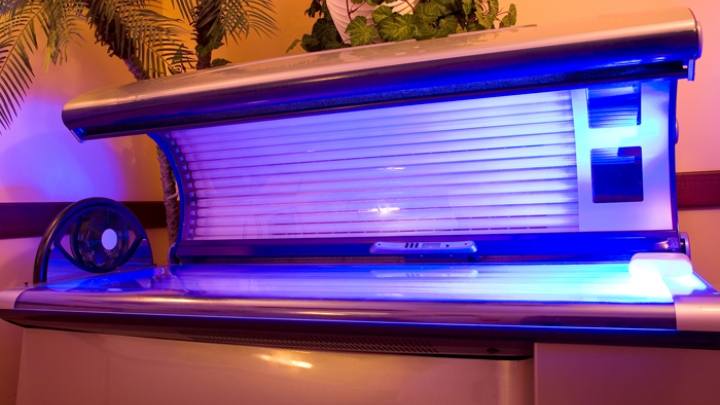(RxWiki News) Beware of health claims promoted by the indoor tanning industry. In reality there are few benefits if any and tanning devices dramatically increase the risk for skin cancer.
Millions of Americans use tanning beds or sunlamps to maintain a year-round glow. They may also be using them to get more vitamin D. This is produced when the skin is exposed to ultraviolet (UV) radiation, as from sunlight.
Some sunlamps are marketed specifically for vitamin D production. And some manufacturers go so far as to claim not only that their tanning beds are safe, but also that they will:
- Boost your mood
- Relieve joint pain
- Reduce cellulite
- Even make your skin look younger
Could tanning this way actually be healthy? The multi-billion dollar tanning bed industry wants you to think so.
- In recent years, they have been calling dermatologists, sunscreen manufacturers, and health organizations the “Sun Scare” industry.
- Besides blaming them for widespread vitamin D deficiencies, the tanning bed industry argues that the connection between UV exposure and skin cancer has never been proven.
If that sounds like tactics used by the tobacco industry a few decades ago, it’s no coincidence.
Here’s a reality check, the International Agency for Research on Cancer categorized UV-emitting tanning devices as “carcinogenic to humans.” That is the highest cancer risk category. It's on par with cigarettes and asbestos. According to its report, people who start using tanning beds or sunlamps before age 30 increase their risk for melanoma, the deadliest skin cancer, by 75%. Studies since then have only added to the evidence.
Don’t get burned
Many major health and government groups worldwide, strongly recommend against indoor tanning.
- Children and adolescents should especially avoid tanning beds. That's because they are more vulnerable to the harmful effects of UV.
- If you want to look like you’ve been “kissed by the sun,” check out sunless tanning products.
- Better yet, instead of being swayed by propaganda that tanned skin looks healthier, learn to love your natural skin tone.
As for vitamin D—which is essential for strong bones and possibly has other health benefits—there is no reason to use a sunlamp, even one that is specially designed for vitamin D production.
- The best way to meet your needs is through diet and vitamin D supplements.
- Vitamin D supplements are safe and the recommendation is to have 800 to 1,000 IU a day.
- Natural exposure to the sun is another important way to get vitamin D. However, moderation is important during peak sun hours along with use of sunscreen.
Lastly, be wary of websites affiliated with the tanning bed industry. Not only do they spread misleading health claims about tanning, they tend to make vitamin D sound like a cure-all.
6 tanning bed myths
Ultraviolet (UV) radiation—whether from sunlight or sunlamps—increases skin cancer risk. Damage builds up over many years. It also accelerates skin aging.
Don’t believe the following claims made by the tanning bed industry.
- Tanning lamps are “safe” and have no “harmful rays” or “adverse effects.”
- Indoor tanning is not safer than tanning in the sun.
- There is no “safe” way to tan.
- Even “low pressure” sunlamps and those that claim to provide “controlled” doses of UV are harmful.
- A “base tan” from indoor tanning prevents future sunburns.
- Not so. The UV spectrum emitted from most sunlamps darkens skin primarily due to oxidation and redistribution of preexisting melanin (the pigment in skin that absorbs UV).
- It has a minimal effect on the amount of melanin. The resulting tan is thus mostly cosmetic, not protective.
- Indoor tanning is healthy for young people.
- In an investigation by the U.S. House Energy & Commerce Committee, four out of five tanning salons made such false claims when contacted by people pretending to be fair-skinned teenage girls.
- Nearly all the salons denied the known health risks, with half denying that tanning increases skin cancer risk, calling that a “big myth,” “rumor,” or “hype.”
- Tanning beds are a safe way to get vitamin D.
- Some sunlamps can induce production of vitamin D, but as the FDA states, “it is unclear whether the benefit of such production outweighs the risks of use.”
- Diet and supplements are a safe—and effective—way to get vitamin D.
- Tanning beds reduce the risk of cancer by increasing vitamin D levels.
- Though vitamin D has been linked in many observational studies with reduced risk for some cancers (such as prostate, breast, and colon), results have been inconsistent and don’t prove cause and effect.
- In any case, even if vitamin D has anticancer benefits, there are no studies indicating that it has to come from sunlight or sunlamps.
- Tanning beds help treat seasonal affective disorder (SAD).
- It’s true that bright (visible) light can have therapeutic effects on this mood disorder, but there’s no definitive evidence that UV (invisible) rays have the same benefit.
- In fact, special lamps designed to treat SAD filter out most UV.

